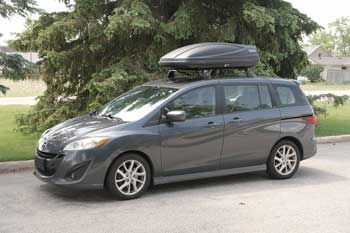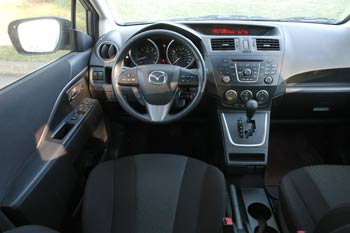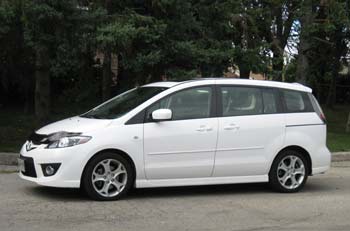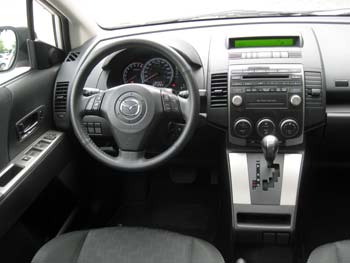Mazda 5 2006-2015: pros and cons, common problems
By Vlad Samarin, Updated: February 18, 2024
The Mazda 5 is a 'mini' minivan. It's powered by a 4-cylinder engine and rides on the Mazda 3 platform. It's available with an automatic or manual transmission. The Mazda 5 offers seating for six and has sliding rear doors.
On the road, it's nimble and fun to drive. It handles more like a sporty wagon than a minivan.
Inside, the Mazda 5 is simple and practical, but tall drivers may find the driver's seat doesn't slide back far enough. The third-row seat space is tight and suitable only for children. Second and third-row seats fold down.
For 2012, the Mazda 5 has been redesigned and received a 157-hp 2.5L 4-cylinder engine. The Mazda 5 was discontinued in the U.S. after 2015 and in Canada after 2017.
Pros:
- Compact Size: The Mazda 5's compact dimensions make it easy to maneuver or park in tight spaces.
- Flexible Seating: With three rows of seats, the Mazda 5 offers versatile seating configurations for passengers and cargo.
- Fuel Economy: Equipped with fuel-efficient engines, the Mazda 5 delivers good fuel economy, making it cost-effective for daily driving.
- Responsive Handling: The Mazda 5 offers nimble handling and precise steering, providing an engaging driving experience.
- Sliding Rear Doors: Sliding rear doors make it easy for passengers to enter and exit the vehicle, especially in tight parking spaces.
- Reliable Powertrain: The Mazda 5, especially the 2012-plus model, has a reliable engine and transmission making it a dependable choice for used car buyers.
- Easy to Work on: The Mazda 5 is a small simple minivan with a small engine making DIY projects easier.
Cons:
- Limited Power: The Mazda 5's engines may feel underpowered, especially when fully loaded with passengers and cargo.
- Limited Legroom: The driver's seat does not slide back far enough.
- Cramped Third Row: While the Mazda 5 offers three rows of seats, the third row space is limited.
- Outdated Technology: Compared to newer models, the Mazda 5's technology features feel outdated, lacking modern connectivity options and advanced safety features.
- Interior Quality: Some may find the interior materials and build quality to be less refined compared to competitors in the same class.
- Rear Visibility: The Mazda 5's rear visibility is hindered by thick pillars and small rear windows, making parking and maneuvering more challenging.
Rear shock absorbers can leak or break off at the top mount. The symptom of the broken top mount is a loud rattling noise in the back. Rear shock replacement costs $140-$230 per side. If the top mount breaks off, but the shock itself is in good shape, the top mount can be replaced separately (aftermarket parts are available).
If the car starts in Neutral but doesn't start in Park, it's typically caused by rust at the pivot point where the transmission cable connects to the transmission. Lubricating the pivot point often solves the problem.
The 2006-2010 Mazda 5 suffered from rust damage, especially in the "salt belt" states.
The A/C compressor electric clutch is known to fail and cause the A/C not to work in the 2006-2010 Mazda 5. The aftermarket clutch kit is available and is cheaper to replace. In some cases, the A/C compressor may need to be replaced.
The Check Engine light with the codes P0126 or P0128 is often caused by a bad thermostat. Replacing a thermostat will cost around 1.5 hours of labor plus parts.
A bad transmission control module can cause jerky transmission engagement and the AT warning light to come on. The part (TCM) costs a few hundred dollars, but replacing it is not very difficult; it's bolted to the transmission under the battery. The key is to use the correct part number. Cheaper aftermarket or rebuilt TCM modules are available online, but the quality is not consistent.
The top engine mount can fail, but it's not very expensive to replace (1.0 hour of labor plus the part). The symptom of a bad top engine mount is increased engine vibration at idle felt inside. Read more about the engine mount.
The Check Engine light with the DTC P0139 could be caused by excessive carbon buildup in the throttle body. Read more about the throttle body. The fix involves cleaning the throttle body and updating the PCM software, if available.
The connector at the center high-mounted stop LED brake light can get corroded at a higher mileage. The connector might need to be replaced together with the LED light assembly.
A leaking EVAP vent valve in the 2012-plus Mazda 5 can cause the Check Engine light with the EVAP leak codes (P0442, P0356). The part is not expensive and is easy to replace. Watch this YouTube video.
In the 2006-2010 Mazda 5, the Bluetooth module can malfunction and cause the battery to drain overnight. The module is located in front of the glove box under the dash.
Summary
The Mazda 5 is a good car with a reliable powertrain. It's small and practical. The driver's legroom could be a deal-breaker for tall drivers. We recommend the 2012-plus Mazda 5, as it's more reliable and less prone to rust. Yes, It will have some problems with the suspension and rear tires can wear prematurely, but the engine and transmission are good and will last long with proper maintenance.With third-row seats in use, cargo space is limited, so if you are planning to use the Mazda 5 for long family trips, consider installing a roof box. Tires need to be rotated regularly to prevent uneven wear at the back.
Related reviews:
Honda Odyssey 2011-2017
Honda Pilot 2009-2015
Mazda CX-9 2007-2015
Dodge Journey 2009-2020
What to look for when buying a used Mazda 5: Check the driver's seat space, tall drivers may find the driver's space limited. Test the air conditioner, as it might not be very strong in warm climates. We recommend looking for the 2012-plus Mazda 5 as it is more reliable. It has a stronger suspension and was less affected by rust issues. The 2.5L engine of the 2012-plus Mazda 5 is solid and can last long with regular oil changes. We spoke to the person who drove the 2012 Mazda 5 as a shuttle and he was very happy with it. He said the car served well and had zero problems outside of regular maintenance.
Fuel Economy: The 2006-2007 Mazda 5 automatic gets 19 mpg city and 24 mpg highway. The fuel economy has been improved for 2008; the 2008-2010 Mazda 5 auto is rated at 21/27/23 mpg city/highway/combined. The 2014-2015 Mazda 5 automatic gets 21 mpg city and 28 mpg highway (24 mpg combined). The 2014-2015 Mazda 5 can travel up to 382 miles (599 km) on a tank of gas.
Engine: The 2006-2010 Mazda 5 comes with a 157-hp 2.3-liter 4-cylinder DOHC (model L3). It's a pretty good and easy to maintain engine. The 2012-2015 Mazda 5 received a 2.5L inline-4, model L5. It is a solid and reliable motor.
Timing Chain or Timing Belt? Both the 2.3L and the 2.5L Mazda 5 engines have a timing chain; there is no timing belt. In the Mazda 5, a timing chain can last for the lifetime of the vehicle.
Maintenance tips: Keep the oil level topped up, as the engine may consume oil at higher mileage. Rotate your tires regularly to prevent rear tires wearing on the inside. The Mazda 5 is a light-weight vehicle; if you want better traction during winter, install winter tires. The transmission fluid needs to be changed when dirty; typically every 35,000-50,000 miles. A cabin filter is often neglected; it needs to be replaced every 25,000 miles (40,000 km) or 2 years, or more often when driving on dusty roads. If the steering wheel is not centered when driving straight, the wheel alignment needs to be checked.
Engine oil capacity:
2006-2010 Mazda 5 2.3L engine (with filter): 4.5 qt. (4.3 liters)
2012-2015 Mazda 5 2.5L engine (with filter): 5.3 qt. (5.0 liters).



